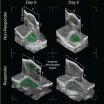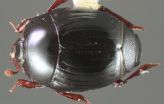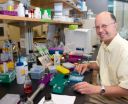(Press-News.org) The research was published early in the January issue of the journal Technology in Cancer Research and Treatment. The article describes experiments using ultrasonic molecular imaging (USMI) and Dynamic Contrast Enhanced-Perfusion Imaging (DCE-PI) to measure response to therapy for pancreatic cancer.
Paul Dayton, PhD, senior author says, "What we found is that using two non-invasive technologies, we can detect response to therapy earlier than by relying on tumor volume changes. Having new non-invasive, inexpensive technologies available to measure response to therapy earlier during the course of treatment would be a significant advance in the ability to tailor a person's treatment to improve outcomes."
Dr. Dayton, an Associate Professor of Biomedical Engineering, worked with Jen Jen Yeh, MD, Associate Professor of Surgery and Pharmacology, to evaluate the imaging technologies on human pancreatic cancer in a pre-clinical model. Both faculty are members of the Lineberger Comprehensive Cancer Center.
USMI has the ability to characterize non-invasively the biologic processes at the cellular and molecular levels. It does this through the use of targeted contrast agents, which are markers that bind to specific proteins expressed on cancer cells within the body. These contrast agents enable a standard ultrasound system to detect signals from cancer cells that would otherwise be undetectable.
Ultrasound DCE-PI is a method used to non-invasively monitor the blood flow in the microcirculation. Since growing tumors require abnormally increased blood flow, changes in blood vessel structure or density can provide information regarding tumor malignancy.
The team used a drug that inhibits a protein specific to tumors. They then used the imaging tools to measure the response of two different tumors, one known to respond to the drug therapy, and a second known not to respond. The results indicated that USMI was able to detect molecular signs of tumor response to therapy after only 2 days. A change in blood flow in the tumor was observed to detect response after day 14 using DCE-PI. Over the same period, standard volume measurements were not able to detect therapeutic response, and prior studies suggested that volume measurements do not become indicative of response until approximately 28 days. Thus, these methods showed a notable improvement in the early identification of tumor response to therapy, using contrast enhanced ultrasound imaging.
Although the contrast agents for USMI are not yet available in the United States, they are currently in clinical trials in Europe for cancer imaging.
INFORMATION:
Other contributors to the study are: J.E. Streeter, MS; from the Joint Department of Biomedical Engineering at UNC and North Carolina State University, and S.G. Herrera-Loeza, BS; and N.F. Neel, PhD; from UNC Lineberger Cancer Center.
Funding for the study was provided by UNC Lineberger Comprehensive Cancer Center, NIH RO1 EB009066,(Dayton), RO1CA140424 (Yeh) and the American Cancer Society 118777-PF-10-023-01-CSM (Neel).
Preclinical study shows potential of new technologies to detect response to cancer therapy earlier
2013-02-20
ELSE PRESS RELEASES FROM THIS DATE:
Pitt study examines cost-effectiveness of medicare drug plans in schizophrenia and bipolar disorder
2013-02-20
PITTSBURGH, Feb. 19, 2013 – A new study published online today in the American Journal of Managed Care found that in Medicare Part D, generic drug coverage was cost-saving compared to no coverage in bipolar disorder and schizophrenia, while also improving health outcomes. Researchers from the University of Pittsburgh School of Medicine, the Pitt Graduate School of Public Health, and Western Psychiatric Institute and Clinic of UPMC note that policymakers and insurers should consider generic-only coverage, rather than no gap coverage, to both conserve health care resources ...
Using millions of gigs of data to improve human health
2013-02-20
With biomedical scientists struggling to collect and analyze millions of gigabytes of data in their efforts to improve human health, the National Institutes of Health has launched a $700 million project to develop a common data-sharing framework and start training future scientists to tap that gold mine of information. That's the topic of a story in the current edition of Chemical & Engineering News (C&EN), the weekly newsmagazine of the American Chemical Society, the world's largest scientific society.
Britt E. Erickson, C&EN senior editor, explains that biomedical researchers ...
Little did we know about beetle diversity: Astonishing 138 new species in a single genus
2013-02-20
The tropics are home to an extraordinary diversity of insect species. How great is it, exactly? We do not know, but today, researchers at the Santa Barbara Museum of Natural History published a study on tropical beetles that can help us progress towards an answer to this question. The paper was published in the open access, peer-reviewed journal Zookeys.
Entomologists Michael Caterino and Alexey Tishechkin have named 138 new species within the genus Operclipygus (the name refers to their clamshell-like rear end), thereby increasing the size of the genus over six times. ...
Potential benefits of inertial fusion energy justify continued R&D
2013-02-20
WASHINGTON -- The potential benefits of successful development of an inertial confinement fusion-based energy technology justify investment in fusion energy research and development as part of the long-term U.S. energy R&D portfolio, says a new report from the National Research Council. Although ignition of the fusion fuel has not yet been achieved, scientific and technological progress in inertial confinement fusion over the past decade has been substantial. Developing inertial fusion energy would require establishment of a national, coordinated, broad-based program, ...
Molecules assemble in water, hint at origins of life
2013-02-20
The base pairs that hold together two pieces of RNA, the older cousin of DNA, are some of the most important molecular interactions in living cells. Many scientists believe that these base pairs were part of life from the very beginning and that RNA was one of the first polymers of life. But there is a problem. The RNA bases don't form base pairs in water unless they are connected to a polymer backbone, a trait that has baffled origin-of-life scientists for decades. If the bases don't pair before they are part of polymers, how would the bases have been selected out from ...
Being stoic for the spouse's sake comes at a high cost
2013-02-20
Among life's many tragedies, the death of a child is one that is perhaps the greatest for parents. No matter what the age of the child or the cause of death, the irrefutable fact of the loss is one that shatters the normal cycle of life, leaving parents traumatized and often incapacitated by grief.
Research on coping with bereavement has focused primarily on the individual, despite the fact that family and married relationships are all profoundly disrupted by the loss. But in the wealth of studies about parental grief, little attention has been paid to precisely how couples ...
Study: Resveratrol shows promise to protect hearing, cognition
2013-02-20
DETROIT – Resveratrol, a substance found in red grapes and red wine, may have the potential to protect against hearing and cognitive decline, according to a published laboratory study from Henry Ford Hospital in Detroit.
The study shows that healthy rats are less likely to suffer the long-term effects of noise-induced hearing loss when given resveratrol before being exposed to loud noise for a long period of time.
"Our latest study focuses on resveratrol and its effect on bioinflammation, the body's response to injury and something that is believed to be the cause of ...
Children with brain lesions able to use gestures important to language learning
2013-02-20
ATLANTA – Children with brain lesions suffered before or around the time of birth are able to use gestures – an important aspect of the language learning process– to convey simple sentences, a Georgia State University researcher has found.
Şeyda Özçalışkan, assistant professor of psychology, and fellow researchers at the University of Chicago, looked at children who suffered lesions to one side of the brain to see whether they used gestures similar to typically developing children. She examined gestures such as pointing to a cookie while saying "eat" to ...
The ethics of access: Comparing 2 federal health care reform efforts
2013-02-20
ANN ARBOR, Mich. — Two major health reform laws, enacted 25 years apart, both try to meet an ethical standard to provide broad access to basic health care. Neither quite gets there -- but it's not too late for modern health care reform to bring the nation closer to a goal of comprehensive and coordinated care for all.
That's the conclusion of a commentary published in the new issue of the Journal of the American Medical Association by a team of University of Michigan Health System physicians.
The authors – a family physician, an emergency physician and a primary care ...
Smoking cessation in old age: Less heart attacks and strokes within 5 years
2013-02-20
Professor Hermann Brenner and colleagues analyzed the data of 8.807 individuals aged between 50 and 74 years using data of Saarland citizens. "We were able to show that the risk of smokers for cardiovascular diseases is more than twice that of non-smokers. However, former smokers are affected at almost the same low rate as people of the same age who never smoked," says Brenner. "Moreover, smokers are affected at a significantly younger age than individuals who have never smoked or have stopped smoking." For example, a 60-year-old smoker has the same risk of myocardial infarction ...


